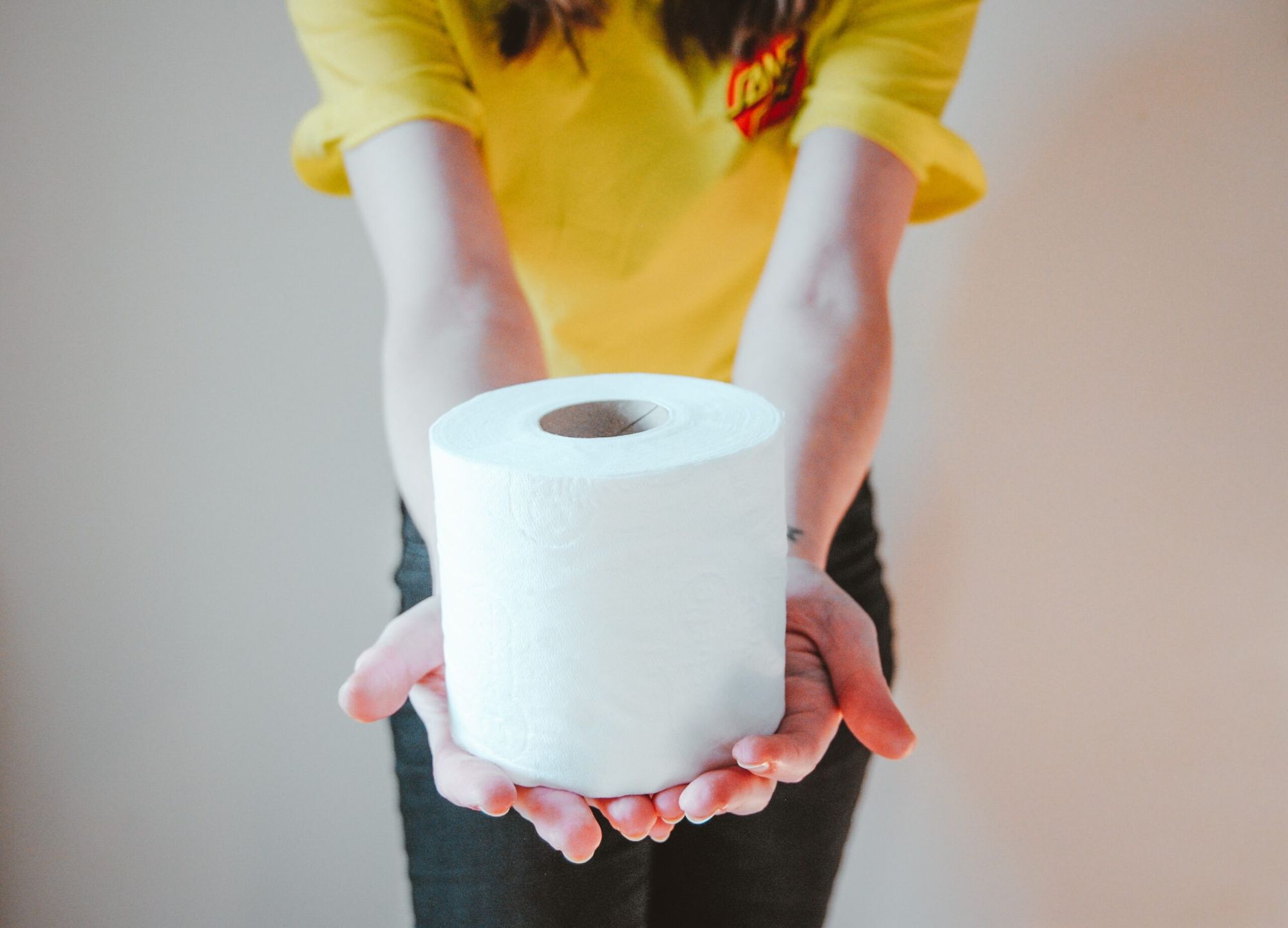
We know you don’t want to talk about your bowel movements (no one really does), but you might be interested to know what your stool says about your health. There are benefits to you getting comfortable enough to talk about your stool with your doctor.
You’ve seen the T-shirt: Everybody poops. So let’s shake off any embarrassment and start taking our stool seriously. After all, noticing certain changes in your stool and understanding what your stool says about your health is an excellent preventative health measure.
It’s understandable that your stool is typically a private matter. People usually do their business and flush it down the toilet immediately. Most people don’t even want to look at their own stool and cringe when they smell this foul excrement. The caveat, however, is that it’s healthy to pay attention to your bowel movements. Why? Because your stool can provide a strong indicator of what’s going on in your digestive health. What your stool says about your health is often quite significant.
It’s also vital to pay attention to the colour of your urine. There have been cases of people who missed their first signs and symptoms of bile duct cancer because they didn’t notice their urine was turning a fluorescent, neon colour.
Changes in your stool and urine don’t always mean you have a serious health condition such as cancer, however, what your stool says about your health can be something that you’d want to know.

Removing Waste from Your Body
Remember, removing waste is a vital part of your body’s digestive process. In human anatomy, stool typically forms in the large intestines. Though it may look and smell gross, defecating is your body’s way of eliminating harmful waste and toxins. In addition, you need to poop for your overall health. Notably, changes in the shape, colour, and consistency of your stool can suggest signs of digestive problems, infections, or more serious health issues such as colorectal cancer.
Yes, both a change in urine or a change in stool can be a sign of certain types of cancer. For stool, the most common cancer associated with changes in the colour, shape or consistency of stool is colorectal cancer. When it comes to urine, gallbladder cancer and bile duct cancer can change the colour of urine as an early symptom. Remember that catching the early symptoms of cancer can save your life.
Dr. Michael Chen, a Gastroenterologist (specialist of the digestive tract) says that the state of your stool is indicative of your health, especially if there are changes like constipation or diarrhoea. Apart from changes in texture or consistency, the shape and colour is also a tell-tale sign of healthy or unhealthy stool. A healthy stool is usually brown in colour and somewhat soft in form. If you experience issues with your stool, coupled with nausea, abdominal discomfort, weight fluctuations, and changes in appetite, you should seek medical advice. Learn more about what your stool says about your health below:
What Your Stool Says About Your Health: The Bristol Stool Scale
Faecal matter is 75% water. The other 25% pertains to solid matter, consisting of undigested food, inorganic substances, and dead bacteria. Clearly, your body doesn’t need these things, so they have to be eliminated. Usually, it will take three days for food to pass through your system. This will ultimately result in a bowel movement. However, when this stool passes your system slowly or swiftly, it can result in changes to the size, texture, and colour of your poop.
It can be difficult to describe poop, so healthcare professionals use the Bristol Stool Scale. This classifies poop into seven categories, depending on texture and size. You and many other people don’t go around examining each other’s poop. As a result, you may not know what normal is until you learn about it. This scale gives you a clearer picture and shows how long stool is spent in your body before coming out. Check out the scale below:
Type 1: Shaped Like Nuts
This is when your stool looks like separated hard lumps, akin to nuts. They have spent a long time in your bowels and are very hard to pass. Your stool might also be very hard (not soft), a contributing factor in why it’ll be difficult, slow and even somewhat painful to pass. What your stool says about your health, in this case, is that you are constipated. This is a problem because you could risk poisoning your body if constipation lasts too long. If this happens for several weeks, consult your doctor to find the root cause. Constipation may be due to several factors such as:
- Dietary changes
- Medications
- Stress
- Medical illness
Type 2: Lumpy Sausage
A sausage-shaped stool with lots of lumps is also a sign that you’re constipated. This shows that you need more fibre in your diet. You also need to drink water to help the stool move smoothly in your intestines. Exercise will also help in the peristaltic movement of your colon, which is akin to wave-like muscle contractions that move waste.
Type 3: Sausage With Cracks
If your poop looks like a sausage with cracks on the surface, you’ve hit the poop jackpot. Doctors agree that this poop is normal because it is soft and very easy to excrete. If things are working optimally in your body, there’s no reason to take longer than a minute to push out the stool. With poop like this, you can relax because you’ve likely got a pretty healthy digestive system. In other words, what your stool says about your health, in this case, is that your digestion is working and healthy
Type 4: Sausage or Snake-Like
If you’ve got this type of poop that’s smooth and soft, you have another winner. This is another ideal poop consistency that you must strive for. It goes out smoothly without any straining and remains intact when flushed. That being said, doctors agree that everyone’s pooping habits vary. However, they all concur that you must eliminate poop every 1 to 3 days.
Type 5: Soft Blobs
Is your poop like a soft blob with clear-cut edges? Although these are very easy to pass, they can be uncomfortable because once you feel the urge, you need a bathroom ASAP. After all, it would be embarrassing if your bowels “explode” and you lose control in a place other than the loo. This can be a sign of mild diarrhea. Usually, it will go away on its own after a few days.
Type 6: Fluffy and Mushy
If you have fluffy poop with ragged edges that look like mush, you have diarrhea or loose bowel movement. You may experience this kind of poop more than 3x a day. In this instance, you have to replenish lost minerals by taking electrolytes. Apart from water, soups, and juices, you need oral rehydration salts, or even Gatorade will work.
Type 7: All Liquid
When you have a water stool with no solid pieces, this suggests that food moved through your bowels too quickly. You must see your doctor if you have 3 or more of these stools within 2 days. You may need a fecalysis or stool exam to see what’s going on. You should also watch out for pain in the tummy, a fever of 102 or higher, and signs of dehydration such as:
- Dry mouth
- Dry skin
- Muscle cramps
- Lethargy
- Fatigue
- Dizziness
- Headache

The Shade of Your Stool
What your stool says about your health when it comes to the colour or shade of your stool is also significant. The Bristol Stool Chart does not discuss colour, but professionals agree that the colour of your stool is also reflective of your overall health. For example, when your stool is not brown, it could indicate gastrointestinal problems. So let’s take a look at the various stool colours:
Brown
Your stool colour depends on your diet and how much bile is processed in faecal matter. Bile is produced by the liver and stored in the gallbladder. Bile produces a fluid that helps your body process and digest fats from your diet. Therefore, a healthy stool is usually any shade of brown. However, bile changes colour sometimes, due to chemical reactions or underlying conditions in the body.
Green
This may surprise you, but if you excrete green poop once in a while, you are perfectly okay. The reason for this could be eating a lot of green veggies or exposure to excessive green food colouring. However, if it happens too often, it could also mean that poop is moving through your digestive tract too quickly, which signifies diarrhoea. As a result, the green tinge coming from the bile did not have sufficient time to break down. If you have green poop for excessive periods, speak with your doctor.
Tinges of Red
Red poop can be alarming, but don’t panic because it can signify many things. You could have eaten something with a lot of red food colour. Alternatively, you could also be taking certain medicines that alter the consistency and shade of your poop. If these are the culprits, your stool should return to normal brown soon. However, a bright red stool that persists is cause for concern. This blood could indicate the following issues:
- Bleeding in the large intestines
- Blood from anal fissures
- Hemorrhoids
- Polyps in the colon
- Colorectal cancer
- Inflammatory bowel disease
Remember, blood in your stool can be a symptom of many conditions, from benign to serious. It signals that there is an issue in your digestive tract, which spans your oesophagus to your rectum and every point in between them. If you keep on passing red stools, consult your doctor for advice as soon as possible.
Black
Black poop could be due to an iron supplement or OTC medicine you took because of a stomach bug. The culprit could also be the black liquorice you feasted on the day before. However, if these scenarios don’t ring true for you, speak with your doctor. Black stool or very dark maroon that looks tarry and smells bad shows there’s bleeding in your digestive tract.
Light Yellow
Yellow-colored stools are great for breastfeeding infants. However, for adults, this is an indication that your stool is too greasy. When your stool has too many fats, it is a tell-tale sign that your body is not absorbing nutrients correctly. Oily and foul-smelling stool means your intestines do not digest and absorb fat as they should. This could be a sign of chronic pancreatitis or celiac disease

White or Gray
If you’ve got a white or chalky stool, it could be a side-effect of the medication you are taking. However, if this does not apply to you, it could indicate you’ve got a clogged bile duct or liver problems. Inform your doctor right away because it is concerning.
How Your Stool Relates to Your Overall Health
Your stool says a lot about your overall health, so it is imperative to try to make the changes required to maintain excellent bowel health. Bear in mind 70% of your body’s immune system is housed in the gut or your digestive tract. If you fail to take care of it, you will be prone to diseases and chronic illness. To keep your bowels movements regular and healthy, take note of the following:
- Eat a balanced diet with fiber to prevent constipation
- Exercise regularly because this helps move your bowels
- Take warm baths to promote more bowel movements
- Drink lots of water to hydrate and clear out toxins
- Stay consistent with colon screenings if you have a history of inflammatory bowel disease, colorectal cancer, or are over 45 years old
Although all this poop talk might make you squeamish, examining it is important to your health, as is understanding what your stool says about your health. Pay attention to the texture, colour, and smell of your poop so you can be aware of when something is amiss. Catching signs of health issues early can nip issues in the bud and prevent complications. Besides, you must do everything to protect your health and wellness.
It can be easy and affordable to focus more responsibly on preventive health. If you wish to take advantage of in-depth, personalized health reports to get to know your genetic predisposition to certain states of health, consider taking a CircleDNA test. This DNA test reports on your health in hundreds of categories, including diet and nutritional health, cancer and disease risk, mental health, and more – all based on your DNA. The CircleDNA test is an innovative screening tool that you can administer from the comfort of your home. CircleDNA examines your DNA and reveals genetic health risk factors that you may want to know your genetic risk of, such as colon cancer, cirrhosis, digestive health issues, and so much more. With this wealth of knowledge about yourself, you can make changes in your diet, exercise, and lifestyle habits to ascertain that you can embark on a holistic healthy journey tailored to your needs.






